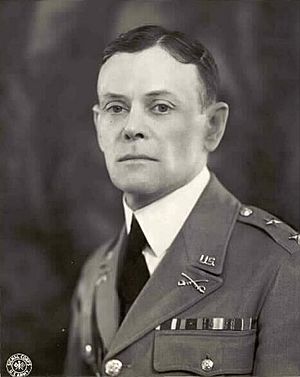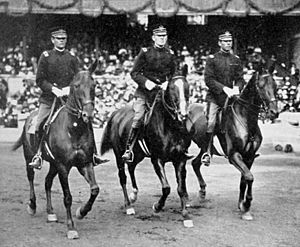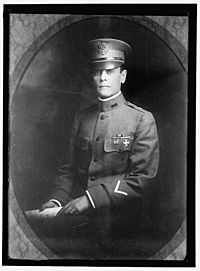Guy Henry (equestrian) facts for kids
Quick facts for kids
Guy Vernor Henry Jr.
|
|
|---|---|
 |
|
| Born | January 28, 1875 Fort Robinson, Nebraska, United States |
| Died | November 29, 1967 (aged 92) Wenatchee, Washington, United States |
| Buried |
Arlington National Cemetery, Virginia, United States
|
| Allegiance | |
| Service/ |
|
| Years of service | 1898–1939 1941–1947 |
| Rank | |
| Unit | |
| Commands held | United States Army Cavalry School Fort Riley Fort Myer 7th Cavalry Brigade 3rd Cavalry Regiment |
| Battles/wars | Spanish–American War Philippine–American War World War I World War II |
| Awards | Army Distinguished Service Medal (2) Silver Star Legion of Honour (France) Companion of the Order of the Bath (United Kingdom) |
| Relations | Guy V. Henry (father) |
| Other work | Olympic equestrian |
| Medal record | ||
|---|---|---|
| Equestrian | ||
| Representing the |
||
| Olympic Games | ||
| Bronze | 1912 Stockholm | Team eventing |
Guy Vernor Henry Jr. (born January 28, 1875 – died November 29, 1967) was an important officer in the United States Army. He was also a famous horse rider. He even competed for the United States in the 1912 Summer Olympics.
Contents
Early Life and Military Beginnings
Guy V. Henry, Jr. grew up in a military family. His father, Guy Vernor Henry, was also a military officer. Guy Jr. graduated from the United States Military Academy at West Point, New York in 1898.
He quickly showed his bravery. In 1899, during the Spanish–American War, he earned the Silver Star. This award is given for courage in battle.
Improving Horse Training in the Army
Henry later studied at the French Cavalry School in Saumur. He used what he learned there to improve how the United States Cavalry trained horses. Instead of "breaking" horses with old Western methods, he taught them gently. He would train them on a longe (a long rope). This slowly taught the horses to accept a rider's weight.
He also brought dressage methods from France and Germany. Dressage is a type of horse training where horses learn to perform specific movements. Henry became a senior instructor at the Mounted Service School at Fort Riley. He made sure new soldiers learned to use riding aids properly. Riding aids are the ways a rider uses their body to tell the horse what to do.
Henry helped make horsemanship at Fort Riley excellent. He developed programs for farriers (people who care for horses' hooves) and veterinarians (animal doctors). These became required courses for cavalry lieutenants. He also replaced the harsh curb bit (a type of horse bit) with softer options like the snaffle bit or double bridle.
Olympic Equestrian Achievements

Guy Henry was a talented horse rider. He competed in all three Olympic equestrian sports. These are dressage, eventing, and show jumping. He represented the United States during his time in the army.
His best Olympic results came at the 1912 Summer Olympics in Stockholm. He won a bronze medal in the team eventing competition. He also placed 11th in the individual eventing. In team jumping, his team finished 4th. He placed 13th in the individual dressage competition. He rode a horse named Chiswell in these events.
After competing, Henry continued to be involved in the Olympics. He was the Chef d'Équipe (team leader) for the U.S. Equestrian Teams from 1936 to 1948. He also led the Olympic Equestrian Committee from 1930 to 1960. He even directed the equestrian events at the 1932 Summer Olympics in Los Angeles.
Other Important Roles
Guy Henry Jr. held many important positions throughout his life:
- He was the Commandant of Cadets at West Point from 1916 to 1918. This meant he was in charge of the students there.
- He commanded the 15th Division from 1918 to 1919.
- He graduated from the United States Army War College in 1921.
- He was the Commander of Fort Myer, Virginia, from 1927 to 1930.
- He became the Chief of Cavalry for the United States Army from 1930 to 1934. This was a very important role for horse soldiers.
- From 1935 to 1938, he was the Commandant of the US Army Cavalry School and Commander of Fort Riley.
- He was a judge at international horse shows.
- He directed the U.S. Equestrian Team.
- He was the President of the Fédération Équestre Internationale (FEI) from 1931 to 1935. He was the only American to hold this position. The FEI is the world governing body for horse sports.
Military Awards and Honors
Guy Vernor Henry Jr. received many awards for his service:
| Army Distinguished Service Medal (with oak leaf cluster) | |
| Silver Star | |
| Spanish War Service Medal | |
| Philippine Campaign Medal | |
| Army of Puerto Rican Occupation Medal | |
| World War I Victory Medal | |
| World War II Victory Medal | |
| American Defense Service Medal | |
| American Campaign Medal | |
| European-African-Middle Eastern Campaign Medal with two campaign stars | |
| Chevalier of the Legion of Honour (France) | |
| Order of the Bath (United Kingdom) |
See also
 In Spanish: Guy Henry (jinete) para niños
In Spanish: Guy Henry (jinete) para niños


